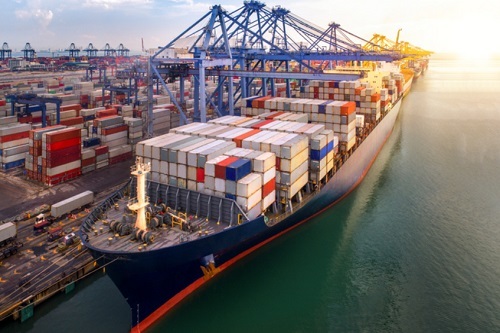Are ultra-large ships leading insurers into deep water?

Authored by Liberty Specialty Markets Head of Marine Mike Burle
Globalisation and economics have led to a growing fleet of giant container vessels on the high seas. Mike Burle explains why it is cause for concern.
If you want an illustration of the state of modern trade, consider my neighbour’s new pizza oven. It’s currently sitting inside a container on a mammoth ship that’s being held in an Egyptian Canal. That pizza oven was to be the centrepiece of a new outdoor seating area. It set sail from Malaysia en route to Rotterdam, tucked inside a container a few months ago. By March it was in the Suez Canal – and hasn’t got much farther since. That pizza oven is in one of over 18,000 containers on the Ever Given, the ultra-large container vessel that ran aground blocking the canal for six days. The chances of my neighbour firing up his oven this summer are looking increasingly slim.
Pizza ovens to one side, the impact of the Ever Given’s grounding and subsequent delay by the Egyptian authorities has revealed much about Europe’s dependence on trade from Asia. Supermarket Aldi warned of 30-day delays to goods destined for its discount aisle; furnishing store Ikea said it had 130 containers on the Ever Given; the price of oil rose because of the blockage and vets had to be sent to examine some of the 130,000 head of livestock on 11 vessels from Romania.
Giants of the seas
Mega-container vessels are giants of the high seas. The Ever Given is 400m long and can carry over 20,000 containers (TEUs) when fully loaded. Those containers, if stacked end-to-end, would extend for 70 miles. The cranes required to unload the vessel are around 430ft in height. Only a limited number of ports around the world have the infrastructure and depth of water necessary to accommodate these huge vessels. In the UK, that’s Felixstowe with a new deep-water port at Liverpool under construction.
The Ever Given is not the only mega-container vessel to have run into problems. Last year, the ONE Apus, which can carry 14,000 containers, lost 1,816 of them overboard while en route from China to Long Beach, California, USA due to adverse weather. The vessel had to be towed back to Kobe in Japan for repairs and to unload damaged containers. In another incident, the Maersk Essen in January this year lost 750 containers overboard whole en route from China to Los Angeles. Other containers fell or were damaged in the weather-related incident.
Only a limited number of ports around the world have the infrastructure and depth of water necessary to accommodate these huge vessels.
Rising losses
Between 2008 and 2019, the average number of containers lost at sea each year according to the World Shipping Council was 1,382. The ONE Apus event exceeded that in a single loss. This rise in the number of containers being damaged and lost comes at a time when the marine market is only just beginning to recover from the very soft conditions of the last decade. Hull insurance has been extremely competitive historically – the loosening of terms and conditions and premium creep over a prolonged period have led to deteriorating results. While there has been a correction over the last 18 months, there is still a long way to go before the market achieves sustainable results. With rate adequacy a distant prospect, the concern is that the rise of mega-container vessels may make that adequacy harder to reach. It’s a sobering thought, but there is simply not enough premium in the market should one of these massive vessels get into real difficulty.
At Liberty Specialty Markets, we steer away from writing container vessels – of any size. Even though London is one of the key markets for this type of business alongside Scandinavia, America and Asia, the historical performance of these vessels and the problems they seem to encounter in their operation have dissuaded us from entering this type of hull business. According to the maritime body the International Union of Marine Insurance, a fire breaks out on a container ship every 25 days, usually in connection with cargo.
Accumulating risk
But even though we steer clear of insuring the hulls and machinery of these behemoths, that doesn’t mean we avoid the exposure altogether. As writers of cargo, goods we insure will inevitably end up on these vessels. In fact, mega-container vessels represent a massive accumulation of risk, which creates all sorts of problems for insurers. Ports and terminals are also exposed: imagine if the Ever Given had got into difficulties within the waters of a port.
The problem caused by the mega-vessels is that the physical loss to cargo and hull doesn’t have to be that severe to incur a very large claim. In 2019, the car carrier MV Golden Ray capsized off the coast of Georgia, US, while carrying 4,200 new cars. The ship’s value was estimated to be around $50m but, so large was the vessel, its removal cost was over $500m. If that wasn’t bad enough, during the process of breaking up the wreck, a fire broke out due to hot work causing another loss. Moving a mega-container requires more tugs or bigger tugs – and a single tug can cost $10,000 a day. If diggers are needed, like they were for the Ever Given, more diggers will be required. As a rule of thumb, the bigger the vessel, the higher the costs and the larger the risk.
For those underwriters who choose to write mega-container vessels, the underwriting will be carried out based on the number of vessels in a fleet. Underwriters will scrutinise each individual vessel, examine the age, tonnage, navigation, survey and loss history. Once that review is complete, a policy will be constructed containing terms and conditions, prices and deductibles. Then, it’s for the client and their broker to discuss.
High-water mark for megaships?
The big question for the insurance market is what the future holds for these mega-vessels. Container vessels were developed in the 1950s but it’s only since the mid-2000s that we have seen the dramatic growth in their size. Globalisation, the rise in trade with Asia and the need to achieve economies of scale have all powered the growth in scale. But on the flip side of the equation, there are still relatively few ports able to cope with these vessels and the pandemic has led many to question the wisdom of economies relying so heavily on Asia for manufacturing, or on global supply chains. Another factor mitigating against further reliance on megaships is that smaller vessels operating in coastal waters could become increasingly attractive as their small carbon footprint makes them more attractive than road and rail for moving goods locally.
The jury is still out on the future of these super vessels, however the Ever Given’s grounding was a warning shot to the maritime world. As attractive as huge vessels may seem economically, they have the potential to create major problems for their owners, maritime authorities, and insurers alike. And whether underwriters choose to engage with them or not, their ability to avoid exposure to them entirely is extremely limited.
If there is one clear lesson for insurers to learn from mega-container vessels, it is the absolute need to maintain underwriting discipline. These vessels present a huge risk, large enough to send a seismic shock right through the marine hull market – and wider. With recovery so close at hand, if we take our hands off the tiller and let terms and condition loosen, it could only take one Ever Given-type incident to blow a hole in everything we’ve achieved.
As for my neighbour’s pizza oven, perhaps I’ll suggest he orders a replacement from closer to home.
As attractive as huge vessels may seem economically, they have the potential to create major problems for their owners, maritime authorities, and insurers alike.
About Liberty
Liberty Specialty Markets offers specialty and commercial insurance and reinsurance products across key UK, European, Middle East, US and other international locations.
We provide brokers and insureds with a broad range of products through both the Company and Lloyd’s markets and have over 1,700 staff in approximately 65 offices. Liberty Specialty Markets was established in September 2013 bringing together Liberty’s company, syndicate and reinsurance operations into one combined operation, composed of three business units: Commercial, Specialty, and Reinsurance (Liberty Mutual Re). This integrated approach means brokers and clients can benefit from our global reach and operating efficiencies.
Liberty Specialty Markets is part of global insurer, Liberty Mutual Insurance Group, a diversified global insurer, formed in 1912 and headquartered in Boston, Massachusetts. Liberty Mutual is the 5th largest global insurer based on 2017 gross written premium, with over 50,000 employees in 30 countries and economies around the world. Our purpose is to help people embrace today and confidently pursue tomorrow. The promise we make to our customers throughout the world is to provide protection for the unexpected, delivered with care. We achieve this by offering a full range of personal, commercial, and specialty Property & Casualty insurance coverages. Our customers’ trust has earned us the 68th spot on the Fortune 100 list of largest corporations in the U.S., based on 2017 revenue.

